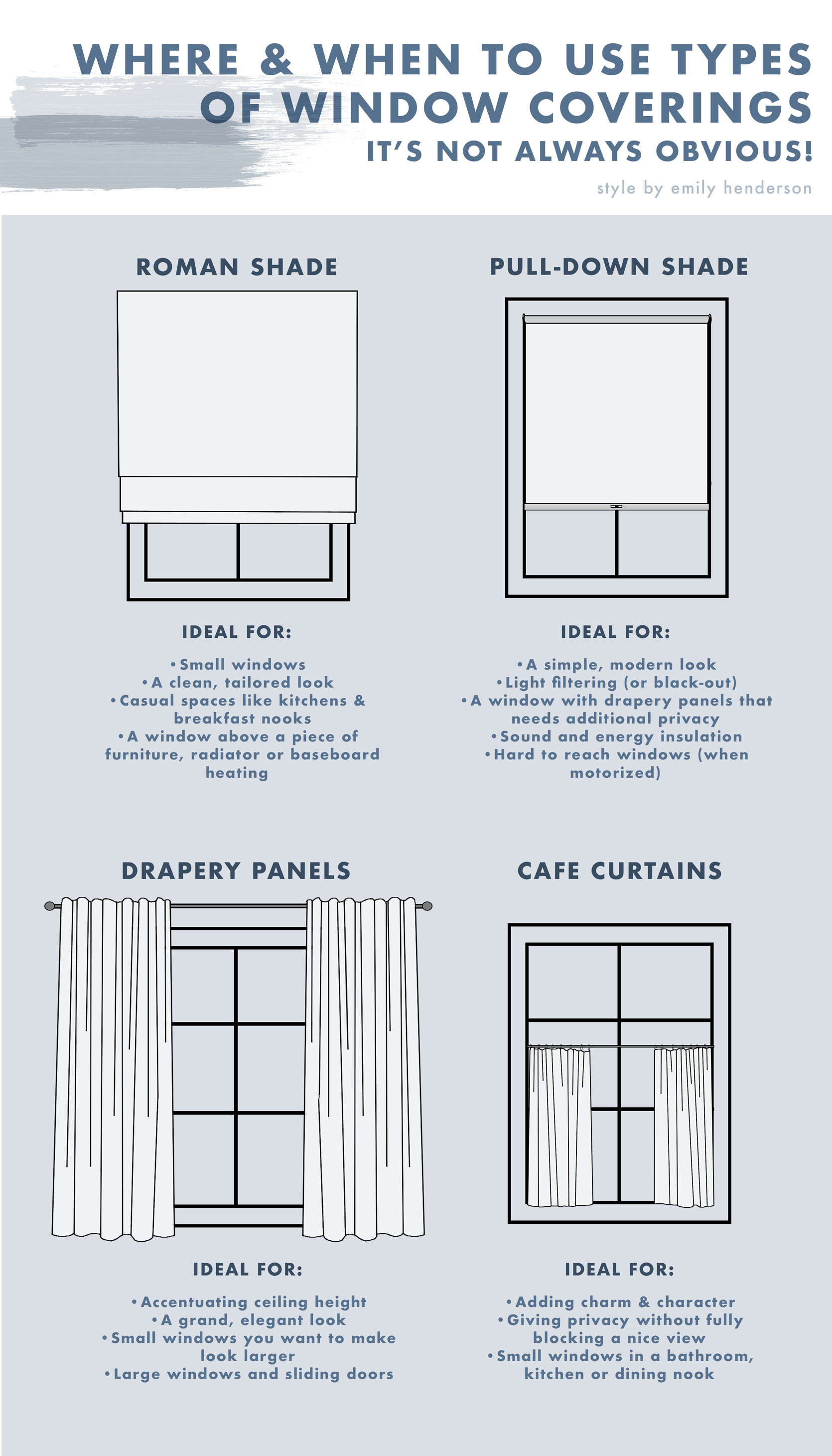It wasn’t until I was deep in the design world that I ever really considered any other window covering besides a curtain panel. It was the only kind my parents used in my childhood home (besides mini blinds and the dreaded vertical blinds). And it’s safe to say the majority of the non-design people in my life who are decorating their own homes also use panels as a default. As elegant as they can be, they are not always the best selection for the window you’re trying to cover.
Say you have a small little window above eye height that panels would look silly on. A roller or Roman shade is going to be your best bet. Or maybe you have a beautiful picture window that faces the street where you don’t want to block the view but you also would rather people walking by not see you hours-deep into a Golden Girls marathon. Light-filtering cafe curtains will do the trick.
If you’ve ever struggled with what direction to go with covering your windows, this post is for you. Oh, and you’re going to want to Pin this info to save for later, too, because it’s advice that will never not be useful.
First, here’s an *actual* cheat sheet for you on when and where to use the four most common types of window coverings: Roman shades, pull-down shades (like rollers and honeycomb), panels, and cafe curtains:

Of course, there is an exception for everything, and these are not die-on-the-hill rules, but I’d guesstimate that they would apply about 90% of the time. And yes, there will be windows where any of the above options would work, and in that case, it’s really just a visual, budget, or maintenance preference. Let’s take a look at all of these more closely to show you examples of why they work where they are pictured (and some other thoughts).
Roman Shades


First up: Roman shades. Super versatile, clean and tailored and a great option for a lot of tricky spaces.
That’s my kitchen up there (and that cute baby is also mine). I have a giant window in my breakfast nook that frankly was very hard to figure out. I could have done panels, but there isn’t much clearance above the window to hang draperies, plus I didn’t want to deal with panels kissing the floor of a VERY active kitchen (anyone who has ever fed a toddler knows what I mean). In her eyes, they’d be two giant napkins and…a hard no for me. So the next option was a shade of some sort. Frankly, a light-filtering roller shade might have been the most practical solution since I don’t want to block daylight, but I knew I wanted a more decorative look to really spruce this side of the space up, so Romans it was. I went with an outside mount as my sill is super shallow and the shade stack would have protruded awkwardly with an inside mount.

How cute is this bedroom? EHD contributor Ajai Guyot had a tiny little window (above a decorative ledge, no less) that didn’t have many options. A Roman is perfect for a window like this since panels would only draw attention to how small it is.

Another spot where a Roman is clutch is above furniture. This is Emily Bowser’s bedroom, and because of the square footage of the room and her home, she really needs to maximize her space. Pulling her dresser out six or so inches to leave room for panels to drape behind was just not a good solution. The drapey Roman she chose is both practical in this application as well as visually soft, not stealing too much attention from anything else in the room.

Another Bowser space where a shade (or cafe curtain) was the best move. As I mentioned, there are going to be plenty of times when you have your pick of what to use, and there isn’t a wrong answer. A cafe curtain would feel charming and Old World, while a Roman is polished and fully covers the window when it’s down at night, etc.
Roman Shade Recap
When to use:
- On a small window where panels would not work aesthetically or functionally
- If you want a clean, tailored look
- In a casual space like a kitchen or breakfast nook
- On a window above a piece of furniture, radiator, or baseboard heating
- As a complement to draperies in a room with a lot of windows
- If you don’t have enough wall space to support drapery rods/panels
Drapery Panels

On to panels. Okay, so this was my old dining room (I MISS YOU!!!) and looking back, I 100% should have opted for Roman shades here. It was one of my first projects, so, as mentioned, panels were my go-to. And look, I love the drama of the deep green velvet panels flanking both casement windows, but could never actually open those windows both because I had stuff on the credenza in front but also because the panels didn’t nest fully to the side of the window so they got in the way. Plus, they collected SO.MUCH.DUST underneath. Pretty, yes, but not practical.
(Hot Tip: If you’re using a Roman shade on a casement window, make sure it’s installed high enough that when the shade is fully up, it doesn’t block the window from opening. It’s not something you need to worry about with a standard single-hung window, but it is for this type.)

I wanted to show you my old living room to talk through two different things: #1 – panels are great for covering a very large window or set of windows you want to make feel like a single window. Honestly, I’m not sure a Roman shade of this width is even a thing (maybe but it would likely have been three instead of one and would have felt choppy). Plus, I wanted to accentuate the ceiling height, which is always a job best done by curtain panels. #2: You see how the panels to the right where the ceiling slopes down don’t line up with the hardware on the large front window? It really wasn’t the end of the world and didn’t bother me that much in person, but panels on the picture window and Roman shades on the two lower, smaller windows would have been a nicer mix, for sure. You live, you learn, (you laugh/love).

I guess I can’t stop showing my old apartment. But for real, it’s just easier for me to talk through the “whys” since I know them. In my old bedroom, I picked curtain panels because I wanted a soft, romantic look, which is exactly what drapes deliver. Cafe curtains would have felt too dinky with the large scale of my furniture (plus it wouldn’t have given me enough privacy), and Romans would have been too stiff for my styling.

Here’s Caitlin’s beautiful, eclectic living room. She opted for a combo of woven Roman shades and panels both for texture, privacy, and drama. I love this combination in a space that’s layered and rich. Any material of shade would work if you want the two window covering types, though typically you’ll want to choose something light-filtering and not too heavy.

We’ve yet to see curtain panels on any doors in this post, but if you’re trying to cover something sliding or even French, panels are a great choice. This dining space by EHD alum Julie makes great use of the lengthening power of panels by hanging the curtain hardware all the way up to the ceiling line to match the cabinetry on the wall and give clean, continual lines to the area.

This sweet little breakfast nook had just about any option available to it for covering that window, but the panels hung high make it feel much grander and more dreamy than it would have with any type of shade or even a short cafe curtain.

This whole room is literally jaw-dropping, but it’s also an ideal example of how dramatic (yet tailored) panels can be. These are inset into the ceiling so there is no visible hardware. It’s a detail that needs to be worked out in the design and renovation process of a room, but man is it worth it. ::chef’s kiss::
Drapery Panel Recap
When to use:
- In any room you want to accentuate ceiling height
- In any room you want a grand, elegant feeling to
- On a window you want to make feel larger (by hanging a drapery rod high and wide)
- When you want to make multiple windows next to each other feel like a single “unit”
- If you have a large window or sliding/French door to cover
Cafe Curtains

Surprise! It’s me showing my home again. A lot of you followed my rental kitchen refresh, and those that did will know I swapped out the wood blinds that were in the window above my sink for a cafe curtain (also called tier curtains). I did this both for charm but also for maximum light.

Another rental space, this time by Julie in a previous apartment of hers. As renters, your options are limited, and cafe curtains hung on a tension rod are so great in a small window that needs privacy but can also be reverted back to move-in condition.

Of course, we all remember Emily’s farmhouse dining nook where she added in a DIY boro fabric cafe curtain. As she doesn’t have a privacy issue necessarily, she opted for the cafe curtain specifically to add print and impact to the space. Cafe curtains are a great way to use up a small piece of fabric you absolutely love but either don’t have the budget to buy tons of yardage or can’t get more because it’s vintage.

Cafe curtains aren’t just for small windows, either. The gorgeous, tall windows in Emily’s farmhouse primary bath let both light and tree views in without letting any ::cough cough:: unwanted views out.
Cafe Curtain Recap
When to use:
- In a room you want both privacy and light/views
- If you want to add some dreamy charm to a space
Pull-Down Shade

I left the most modern and practical window covering type for last but that doesn’t mean you should. Non-Roman shades are typically roller or honeycomb, though you’ll find a few other types. These are usually interior mounted (so you need at least 2-3 inches of window sill), and come in both light-filtering and blackout. Because they sit tight to the window, they also provide great insulation for both sound and temperature. I opted for a honeycomb black-out shade in my daughter’s room behind pretty panels, and while the shade itself isn’t the most aesthetic thing, it kind of disappears and is immensely functional.
In the Portland project from a few years back (above), many of the windows went the way of the shade since the architecture of the home was pretty modern and clean-cut. Could you add panels around the window with this type of shade, too? Yup, absolutely, but if you want something simple and unfussy, this is the window covering for you.

The same applies to the mountain house, which was Emily’s take on modern Scandi lodge. The ceilings, windows and views in this house did the heavy lifting, and covering those up with anything that made too much of a statement would frankly steal from that. You can see how minimal they are when fully open above in the spa bathroom and in one of the guest rooms below.

Pull-Down Shade Recap
When to use:
- When you want a simple, modern look
- If you need privacy with either light-filtering or black-out qualities
- If you need better insulation of sound and energy for your window
- In a space that needs a low-maintenance and low-profile option
And there you have it! I hope that was helpful and useful for you if you’re trying to figure out window coverings in your home. Again, a lot of it is personal preference, but like I walked you through, there *are* right and wrong answers depending on the situation. While drapery panels are the most versatile (read: you don’t usually need to go the custom route like you would for a Roman or pull-down shade), I hope this post opened the window to the world of coverings (pun very much intended here).
See you next time, friends!
Opening Image Credits: Photo by Sara Ligorria-Tramp | From: Portland Project: The Living Room Reveal
THIS POST WAS ORIGINALLY PUBLISHED HERE.


